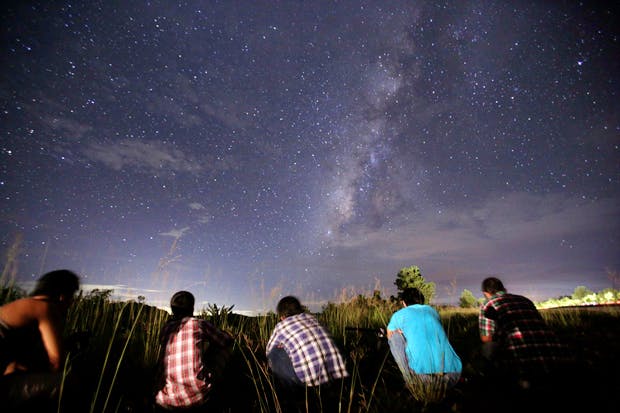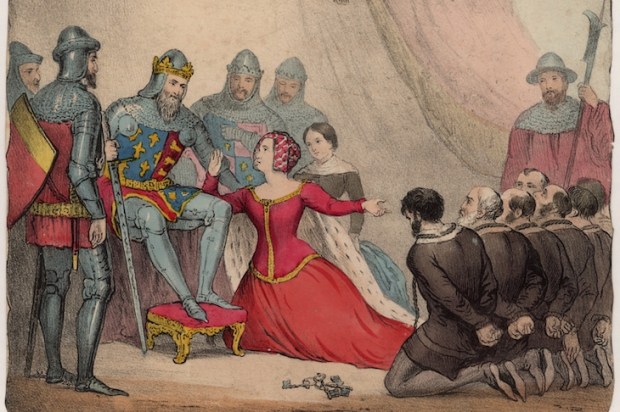‘How many people have you slept with in your life, roughly?’ she asked. We were lying in bed in the morning. ‘You go first,’ I said, needing time to think of the right answer. She looked at the ceiling and thought long and hard. ‘About 50,’ she said finally. I asked her about the worst experience. ‘Your turn, Low life,’ she said. ‘I can’t wait to hear this.’ ‘Well,’ I said, ‘it would take a Professor Brian Cox working with the latest European Space Agency number-crunching software to come up with anything like an approximate figure.’
By a weird coincidence, the next evening I was invited by a friend of a friend to have dinner with Professor Cox at his home. I had neither met him before nor seen him on telly.
Over dinner we talked about Einstein’s theory of relativity being the last word, still, on how we understand the universe. We talked about how the latest theories about the origin of the universe are tending towards the astonishing idea that there was in fact no beginning, and that the universe is eternally going backwards in time as well as forwards. (Astonishing, anyhow, for the couple of hundred world-class physicists and astronomers, but common or garden knowledge for about 80 million Anglicans, 300 million Evangelicals, 600 million Pentecostals and Charismatics and well over a billion Catholics.) We also talked about this pair of once enormous suns, now shrunk to about the size of a couple of tennis balls, and locked together in a sort of shimmying dance. Brian did say how much each of these condensed suns weighed in tons, but I’ve forgotten the incredible number. All I can remember thinking at the time was that the number corresponded roughly to the weight of my ignorance. Their dance moves have been measured to the nearest millimetre, he said.
I say ‘we’ talked about these things. In actuality Professor Cox talked with great articulacy and enthusiasm while I pulled faces at him across the table. These faces ranged from the humorous scepticism of a Jeremy Paxman to — as I trailed further and further in his intellectual wake — a grinning George Formby, a loving, faithful golden retriever, and finally a stupefied gonk.
Then he rocked back in his chair, slapped his forehead and said, ‘I nearly forgot! Tonight is the climax of the Perseid meteor shower! What time is it?’
It was almost 11 o’clock, the time given in the newspaper for the show to start. We grabbed our wine glasses and followed him up two flights of stairs to his roof terrace and lay down in a row on the tiles like victims of a massacre.
Above us the sky was perfectly clear and the stars so magnificent that it seemed to me a terrible pity that I have looked up so seldom during my time on the planet. While a disposable glasses wipe was passed around by the light of my iPhone torch for the benefit of spectacle wearers, Professor Brian Cox pointed out and named some of the major constellations in such a way as to suggest that of course we were all well acquainted with them already but it was just a quick reminder. He then showed us from which point in the sky it would radiate (just below and to the right of the stand-out W of Cassiopeia) and explained the cause, nature and composition of the annual Perseid meteor shower (the meteors are bits of debris from the comet Swift-Tuttle hitting the earth’s atmosphere at 130,000 mph).
What I really wanted to know was which constellation showed the face of Victor Meldrew, but I thought the question perhaps too fatuous to ask of a professor of particle physics and refrained from asking it.
As we settled down to watch and wait, we chatted desultorily, our voices disembodied in the darkness. Someone remembered that today was the Glorious Twelfth, the start of the grouse-shooting season. I, glad to be back in my own element and able at last to contribute something of interest to the evening’s discussion, reported that it had been a terrible year for the grouse because the weather had been too wet for the chicks to thrive. But my crumb of information about the natural world was totally ignored because at that moment the biggest, longest, brightest and thickest meteor I had ever seen shot spectacularly across the face of the heavens, descending obliquely all the way down to the western horizon.
I have seen shooting stars before, of course I have — one or two. But I’d never seen anything like that. We all let out expletives of one sort or another; even Professor Brian Cox OBE was moved to a thrilled profanity. About a minute later — another! Similar magnitude, length and thickness; different direction. After that they came at the rate of one a minute. We lay there in the darkness, oo-ing and ah-ing at the unearthly spectacle. The Glorious Twelfth. Totally amazing.
Got something to add? Join the discussion and comment below.
Get 10 issues for just $10
Subscribe to The Spectator Australia today for the next 10 magazine issues, plus full online access, for just $10.















Comments
Don't miss out
Join the conversation with other Spectator Australia readers. Subscribe to leave a comment.
SUBSCRIBEAlready a subscriber? Log in